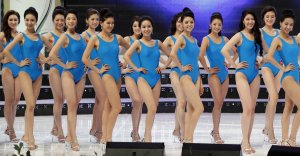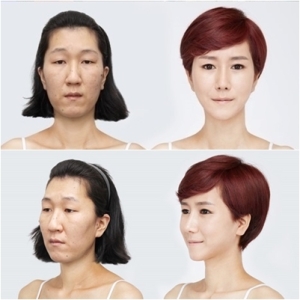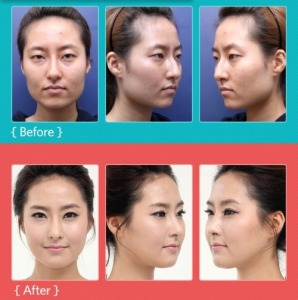Prior to studying plastic surgery in an academic environment, I had never realized how prevalent the industry was in Asia. I stumbled across a tumblr that is dedicated to showing before and after photos of Koreans who had undergone plastic surgery and it is initially striking that the results appear quite similar from person to person. Patients sought out eye widening, face slimming, nose bridge enhancement and two that struck me were head rounding surgeries and calf reduction surgeries. As discussed by Cho Joo-hyun, “concerns over the body in this era of culture” have sky rocketed after the IMF crisis and care services as well as beauty practices and consumerism became prevalent in Korean society among both men and women. Korean culture today deems that those who are in need of aesthetic improvements and do not seek out cosmetic surgeries or modern body care services are considered either “poor or negligent in her or her humane duties.”
Plastic surgery promotion in Korea is heavily concentrated in major city squares as noted on the blog, there are often 4-5 clinics in one area some of which are only 3 blocks apart, many of which are conveniently located next to fast food restaurants and shopping malls. Many of the posts on the blog are Korean patients defending plastic surgery and treating procedures like an “art form.” Some even refer to the blog as a medical tourism blog. Curing body problems has become a common theme among all citizens regardless of social class. As a result, the improvement of human capital seems to have a significant impact on society. Improved physical appearance seems to correlate highly to better jobs and better marriages. Neoliberal ideals, as mentioned by Cho Joo-hyun has created a culture that relies on self empowerment through things like sexual attractiveness, a healthy body and regular self care practices.

Business Insider claims in a recent article that all Koreans strive for the same look, “Light skin, tiny nose, wide eyes with double lids, and a small face with a V-shaped chin.” While this statement is an extreme assumption that all Koreans are obsessed with plastic surgery and this particular image, it is clear that beauty practices have heavily influenced what beauty means in Korean culture. Obsession in body changes are less of a fad in today’s Korean society and are likely to stay ingrained into the culture as a staple of power within the community. (Cho Joo-hyun)


Looking back on our discussions of plastic surgery in America and Brazil, and now adding in South Korea, it seems it is hard to get out of the Western view of looking at the “otherized.” I sometimes catch myself looking through this Westernized lens, specifically today with South Korea. At first glance of the “Miss South Korea Gif” I did think each looked incredibly similar but the facts are that the pictures were indeed photoshopped and the contestants weren’t representing the entire population of South Korea but only a certain region – but leave it to the Westerners to take this evidence at face value, literally. I now see the potential problem of using the term “similar” and saying South Korean women all want to look the same because that is the Western lens. Just like Western women imposed beauty practices onto Afghan women, and Jessica Simpson provided some condescending advice to the people of Brazil, saying South Korean women get plastic surgery to all achieve the same beauty standard can be grouped with the likes of Jessica Simpson and hairdresser Debbie. The problem is not the beauty standard that Korean women want to achieve, or need to achieve, but rather the problem is the neoliberal govermentality that exists in all of these cases and the anxiety the westerners feel as the “otherized” compete with the Westernized.
LikeLike
The pictures you pasted shows how much plastic surgery can change the way someone looks. As the hub for plastic surgery, people form many nations especially in Asia fly to Korea to get plastic surgery. Because of this drastic change, doctors have to issue a certificate so that people can prove to the immigration custom that that are who their passports say they are despite not looking like the passport photo at all. One one hand, this transformation can be life changing in a positive way but can plastic surgery be misused in a way that doesn’t benefit society? To which point does it become a safety issue? Someone dangerous may no longer be detected and caught if they undergo surgery to change the way they look for example.
LikeLike
The concept of plastic surgery as trendy, fashion statement, or political statement is really interesting to me. As an Iranian individual, I definitely see a correlation between the way that plastic surgery is viewed in South Korea and in Iran. Persian people also place a high emphasis on Western ideals of beauty. Iran actually has the highest rate of rhinoplasties (nose jobs) in the world. It is exactly for this reason that for many years now, Iran has been named the nose job capital of the world. Unlike in the United States where people hide at home when they are recovering from cosmetic surgery, people in Iran sport their surgery bandages and nose splints as though it is a fashion accessory. It truly is viewed as a symbol of modernity and glamour, particularly in Iranian youth culture. This VICE article discusses the phenomenon: http://www.vice.com/read/shes-so-najoor-0000467-v21n10 and the header picture showing an Iranian girl with her nose job bandage looks like a page ripped out of a Vogue editorial. The way American media outlets report about nose jobs in Iran is eerily similar to the way they report about South Korean plastic surgery as well using buzzwords like obsession to grab readership and viewership.
LikeLike
One of the many reasons South Korea has such a booming cosmetic surgery industry is its reputation of quality. In China, the desire for capital sometimes outweighs the health of the patient. For example, in April 2013 a 20-year-old woman became blind when an unlicensed practitioner attempted to perform a nose job on her. The report stated that, “[a]ccording to doctors at the Shanghai Changzheng Hospital, it is unlikely that the woman will ever recover her sight […] When asked, the spokesperson of the Beijing Health Department was reluctant to give the exact number of hospitals that had the licenses required to practice, which indicates a lack of uniform regulations.” Yet, in spite of the over 20,000 complaints received every year, the Chinese cosmetic surgery market continues to grow (1).
In order to minimize these risks, many Chinese are applying for medical visas to realize their cosmetic fantasies elsewhere, namely South Korea. “In 2012, 32,503 Chinese tourists came to South Korea for medical services, says a recent report by the Korea Health Industry Development Institute,” surpassing Americans as the largest population of international medical tourists to South Korea (2). In the opinion of one Chinese student attending Peking University these frequent medical pilgrimages by Chinese to South Korea are because South Korean plastic surgeons are more reliable and more experienced since they have been involved in the cosmetic surgery market for longer (3). This is good news for South Korea’s plastic surgeons working in the lagging South Korean economy, observing:
[T]he country’s decline has brought one silver lining: South Korea’s currency has fallen so far that procedures here are now cheap when calculated in dollars and other currencies. This has led to growing numbers of Japanese, Chinese and Korean Americans coming to Seoul for relatively inexpensive cosmetic procedures […] A few larger clinics are even taking the opportunity of a downturn at home to open branches in China, the country seen as the industry’s next big growth market (4).
Dr. Kim Byung-gun’s business has adapted effectively to these circumstances and is a living example of the global nature of the cosmetic surgery market. He estimates that about 30% of his patients are international medical tourists, of whom 90% are Chinese. For this reason he speaks Mandarin and has planned to collaborate with two clinics in China (5). In addition China’s demand for cosmetic surgery benefits the South Korean economy, diffusing its source of national revenue to a service industry so it is not so focused on manufacturers such as Samsung Electronics and Hyundai Motor (6).
(1) Sidibe, Nana. “China’s Plastic Explosion.” – China.org.cn. N.p., n.d. Web.
(2) Kong, Kanga. “Chinese Overtake Americans as Top Medical Tourists in Korea – Korea Real Time – WSJ.” Korea Real Time RSS. N.p., n.d. Web.
(3) Sidibe, Nana.
(4) Fackler, Martin. “Economy Blunts Korea’s Appetite for Plastic Surgery.” The New York Times. The New York Times, 01 Jan. 2009. Web.
(5) Lah, Kyung. “Plastic Surgery Boom as Asians Seek ‘western’ Look.” CNN. Cable News Network, 23 May 2011. Web.
(6) Kong, Kanga.
LikeLike